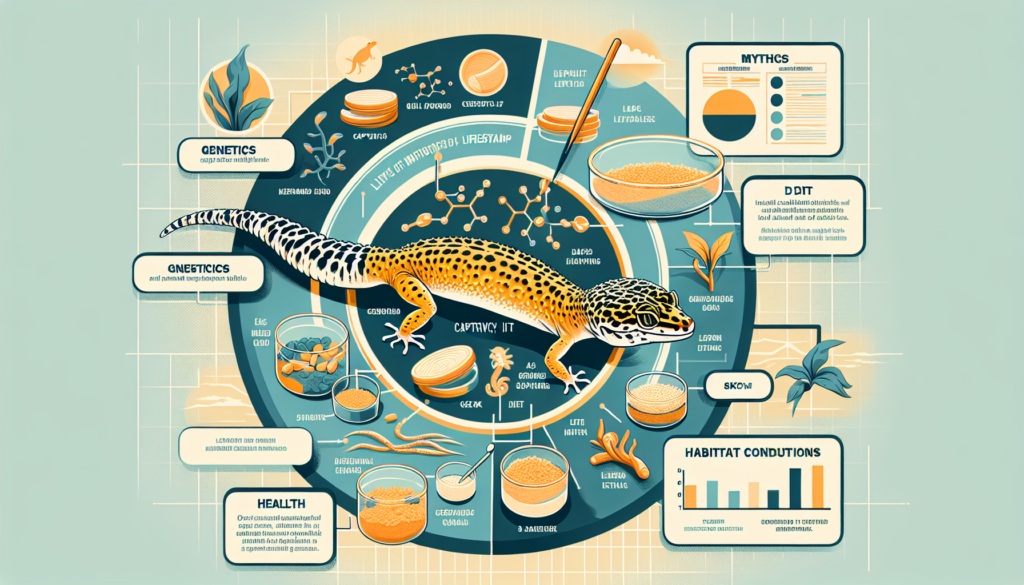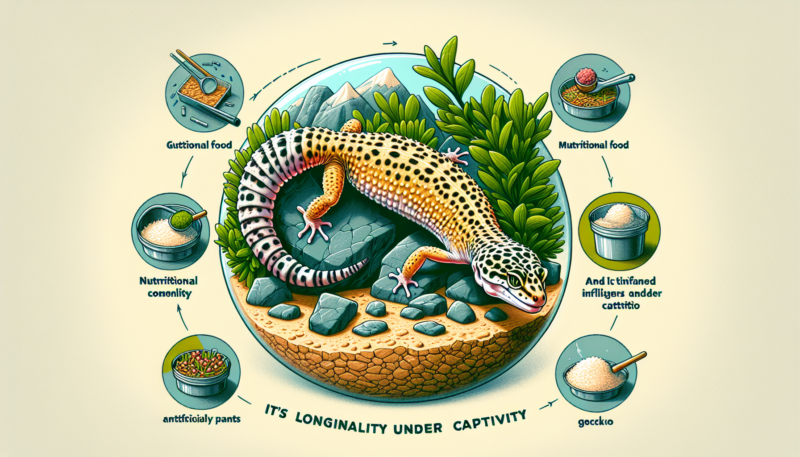Did you know that leopard geckos make fascinating pets? If you’ve ever wondered about the lifespan of these exotic reptiles, you’ve come to the right place. In this article, we will explore the question, “How long does a leopard gecko live for?” We’ll uncover the secrets behind their longevity and reveal useful tips to ensure your leopard gecko lives a happy and healthy life. So, let’s get started on this exciting journey into the world of these captivating creatures.

Life Span of a Leopard Gecko
Welcome to this comprehensive article on the life span of a leopard gecko! If you’re a proud owner of one of these amazing reptiles, or if you’re considering getting one as a pet, it’s important to understand the factors that affect their lifespan and how to ensure they live a long and healthy life. In this article, we will discuss various factors that can impact the life span of a leopard gecko, how to determine their age, their lifespan in the wild and in captivity, the longest recorded lifespan, tips for increasing their lifespan, common health issues, and their impact on lifespan. So let’s dive in and learn more about these fascinating creatures!
Factors Affecting Leopard Gecko Lifespan
Several factors play a crucial role in determining the lifespan of a leopard gecko. It’s important to provide a suitable environment for their needs, ensure they receive a balanced diet, maintain proper hydration, offer necessary healthcare, and regulate temperature and lighting. Let’s explore each of these factors in detail:
Genetics
Just like humans and other animals, genetics plays a significant role in determining the lifespan of a leopard gecko. Some geckos are born with certain genetic predispositions that may affect their overall health and longevity. While we cannot control their genetics, providing a healthy and supportive environment can help minimize the impact of any potential genetic factors.
Habitat and Enclosure
Creating a suitable habitat for your leopard gecko is essential for their overall well-being and longevity. The enclosure should be spacious enough to allow natural movement and include hiding spots, climbing structures, and a warm and cool zone to regulate body temperature. A properly set up and maintained enclosure can greatly contribute to the longevity of your leopard gecko.
Feeding and Diet
Proper nutrition is vital for leopard geckos to thrive and live a long life. Their diet should consist of a variety of live insects, such as crickets, mealworms, and waxworms. It’s important to ensure that the insects are gut-loaded and dusted with calcium and vitamin supplements to provide essential nutrients. A balanced diet that meets their nutritional needs is crucial for their growth, development, and overall health.
Hydration
Maintaining proper hydration is essential for leopard geckos. They obtain most of their hydration from the moisture in their food, but it’s also important to provide a shallow water dish within their enclosure. Regularly cleaning and refilling the water dish will ensure your gecko has access to fresh water, which is important for digestion and overall health.
Healthcare
Just like any other pet, regular veterinary check-ups are crucial for the well-being and longevity of your leopard gecko. A qualified reptile veterinarian can provide preventive care, detect any potential health issues early on, and offer appropriate treatments. Regular check-ups with a knowledgeable veterinarian can help ensure your gecko is in good health and increases their chances of living a long and happy life.
Temperature and Lighting
Leopard geckos are ectothermic creatures, meaning they rely on external heat sources to regulate their body temperature. Maintaining the proper temperature and lighting within their enclosure is essential for their physiological processes and overall health. A temperature gradient should be provided, with a warm basking spot around 88-92°F (31-33°C) and a cooler area around 75-80°F (24-27°C). Additionally, using UVB lighting can help ensure proper calcium metabolism.
Average Lifespan of a Leopard Gecko
Leopard geckos have a relatively long lifespan compared to many other reptiles. On average, they can live for 10 to 20 years in captivity if provided with proper care and a healthy environment. Genetics, diet, habitat, and overall maintenance greatly influence their longevity. By taking care of these factors, you can help ensure your leopard gecko lives towards the upper end of their average lifespan.
How to Determine the Age of a Leopard Gecko
Determining the age of a leopard gecko can be a challenging task, especially for those who adopt or rescue geckos without any background information. However, there are a few indicators that can give you an estimation of their age. Let’s explore these methods:
Birth
If you have witnessed the hatching of your leopard gecko from an egg, you can determine their age easily. Newly hatched geckos typically measure around 3 to 4 inches in length and have a delicate appearance.
Growth Markers
Leopard geckos experience growth spurts during their early stages of life. By monitoring their growth and comparing it to growth charts, you can estimate their age based on size and weight. However, do keep in mind that growth rates can vary between individuals.
Reproductive Maturity
Leopard geckos reach sexual maturity at around 8 to 12 months of age. Once they start displaying reproductive behaviors, such as calling or mating, it is an indication that they have transitioned into adulthood.
Physical Signs of Aging
As leopard geckos age, they may exhibit physical signs such as changes in skin color, loss of vibrancy in their patterns, and the appearance of wrinkles or loose skin. These signs can give you an estimation of their age, although they are not always accurate indicators.

Leopard Gecko Lifespan in the Wild
In their natural habitat, leopard geckos generally have a shorter lifespan compared to those in captivity. Factors such as predation, competition for resources, and changes in weather conditions make their survival challenging. In the wild, their average lifespan is around 6 to 10 years, depending on various environmental factors.
Leopard Gecko Lifespan in Captivity
Under proper care and favorable conditions, leopard geckos can live significantly longer in captivity. With a lifespan ranging from 10 to 20 years, their longevity is attributed to the controlled environment and the absence of natural predators.
Longest Recorded Lifespan of a Leopard Gecko
The longest recorded lifespan of a leopard gecko is an impressive 27 years. This remarkable achievement can serve as inspiration for owners who are committed to providing the best possible care and environment for their geckos.
Tips for Increasing Leopard Gecko Lifespan
While we cannot control the genetic factors that affect the lifespan of a leopard gecko, we can take certain steps to maximize their chances of living a long and healthy life. Here are some tips to help increase their lifespan:
Create a Suitable Enclosure
Make sure the enclosure is properly set up and meets the needs of your leopard gecko. Provide a spacious and enriched environment with hiding spots, climbing structures, and a temperature gradient to allow them to engage in natural behaviors.
Provide a Balanced Diet
Offer a variety of gut-loaded and appropriately supplement-dusted live insects to ensure your gecko receives a balanced diet. Be mindful of portion sizes and frequency of feeding, as overfeeding can lead to obesity and related health issues.
Monitor Hydration
Ensure your leopard gecko has access to fresh water at all times. Monitor their water intake and mist their enclosure regularly to maintain proper humidity levels, especially during shedding.
Maintain Proper Temperature and Lighting
Regularly monitor the temperature and lighting within the enclosure. Use a thermometer and a suitable heat source to create a warm basking spot and a cooler zone. UVB lighting can contribute to their well-being, but always follow manufacturer guidelines to prevent any harm.
Regular Veterinary Check-ups
Schedule regular check-ups with a qualified reptile veterinarian to monitor the health of your leopard gecko. Prevention is key, so consulting with a professional can help detect any potential health issues early on and provide appropriate treatments.
Common Health Issues and Their Impact on Lifespan
Despite your best efforts, leopard geckos can still face health issues that may impact their lifespan. Some of the common health issues include:
Metabolic Bone Disease
Metabolic Bone Disease (MBD) is a condition that affects the proper development and function of bones due to calcium and vitamin D3 deficiencies. MBD can lead to weak bones, deformities, and skeletal abnormalities, significantly impacting the lifespan of a leopard gecko.
Impaction
Impaction occurs when a gecko ingests a substrate or foreign object that cannot be properly digested or passed through the digestive system. This can lead to blockages and other complications that can be life-threatening if not addressed promptly.
Respiratory Infections
Respiratory infections in leopard geckos can be caused by bacteria, viruses, or fungi. Symptoms include wheezing, nasal discharge, difficulty breathing, and loss of appetite. If left untreated, respiratory infections can severely impact their overall health and lifespan.
Parasites
Leopard geckos can be prone to internal and external parasites, such as mites and worms. These parasites can cause a range of health issues, including weight loss, decreased appetite, and weakened immune system, which ultimately affects their lifespan.
Shedding Issues
Proper shedding is essential for leopard geckos to remove old skin and allow for proper growth. Issues with shedding, such as retained shed or constant difficulties shedding, can lead to skin infections or injuries, negatively impacting their health and lifespan.
Tail Loss
Leopard geckos have the ability to voluntarily shed their tails as a defense mechanism, but tail loss can also occur due to stress, improper handling, or accidents. While tail loss itself may not be life-threatening, it can affect their overall well-being and put them at higher risk of injuries or infections.
Other Diseases and Injuries
Leopard geckos can also be susceptible to other diseases and injuries, such as eye infections, mouth rot, fractures, or wounds. Any illness or injury, if not properly treated, can affect their lifespan and overall quality of life.
Conclusion
In conclusion, understanding the factors that affect the life span of a leopard gecko is crucial for providing them with the best care possible. By considering genetics, habitat and enclosure, feeding, hydration, healthcare, temperature and lighting, you can greatly contribute to the long and healthy life of your leopard gecko. Monitoring their age, knowing their average lifespan in the wild and in captivity, and taking preventive measures can also help prolong their lifespan. Remember that each leopard gecko is unique, and while it’s impossible to guarantee a specific lifespan, by following these guidelines and providing attentive care, you can greatly increase the chances of your leopard gecko living a happy and fulfilling life for many years to come!
